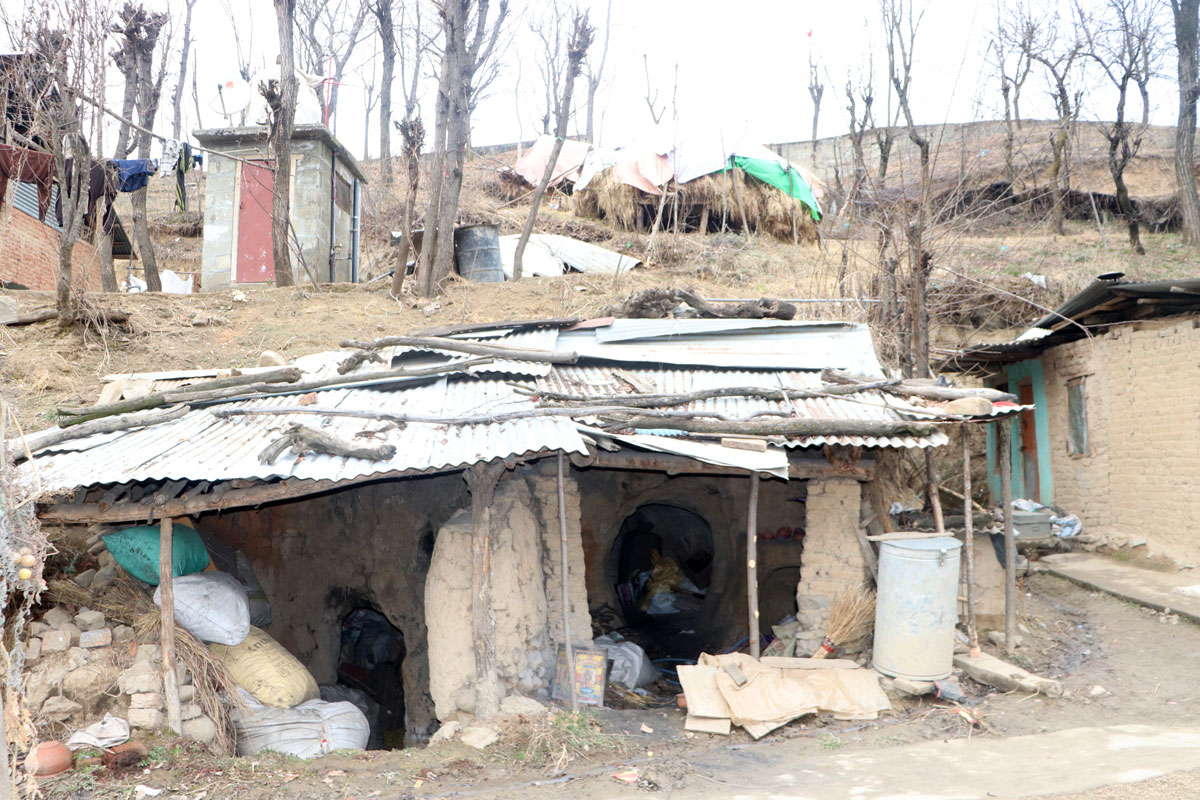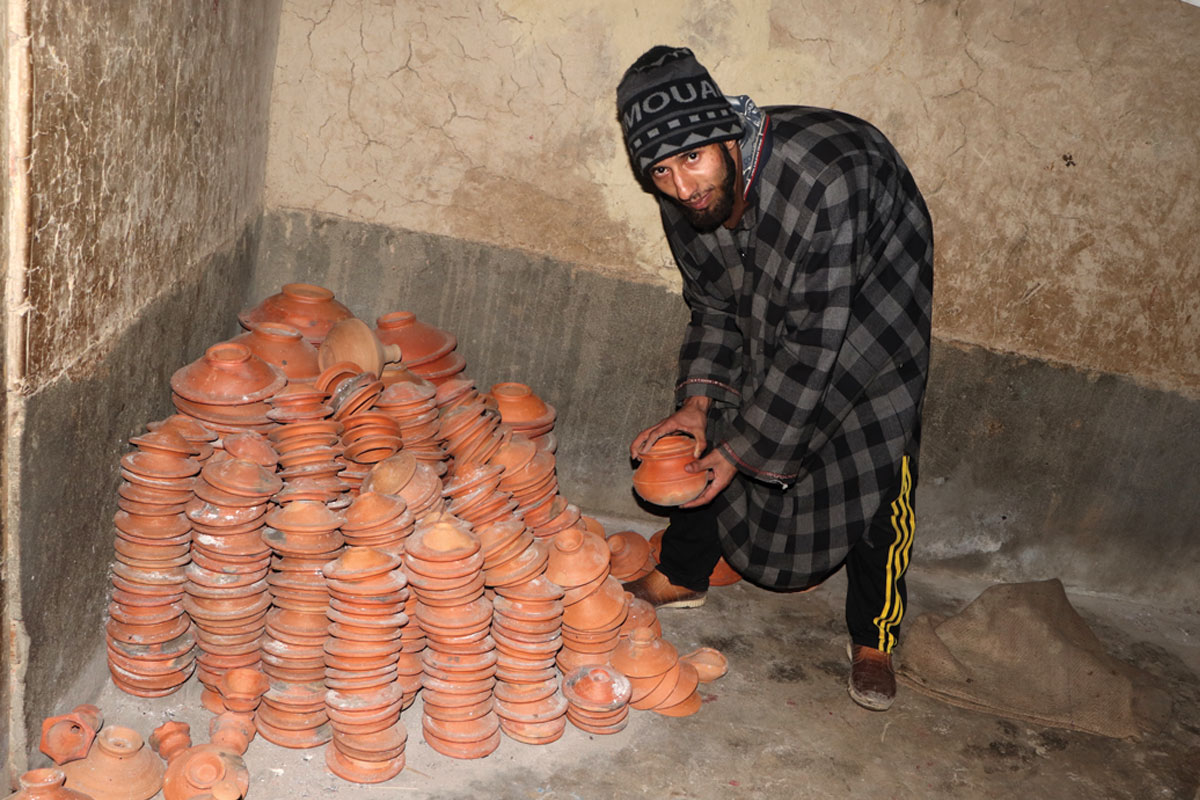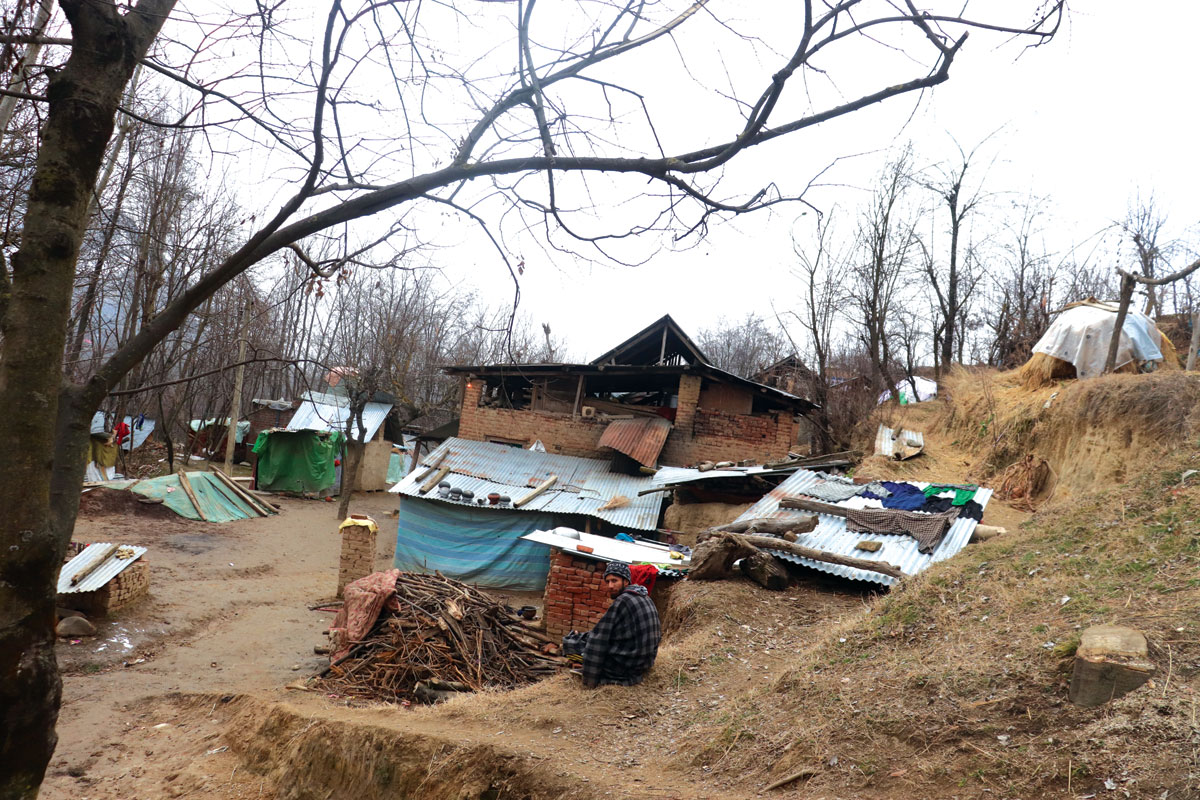On the foothills of Tral is a maze of caves that is an established archaeological site offering details about the early settlements of mankind in Kashmir. More than 3000-year-old site, it holds the keys to understanding the hunter-gathering era of Kashmir and has continuity in history till the man started domesticating the animals and then formal agriculture. Interestingly, the site is still being inhabited by the potters who see these caves as their inheritance, reports Samreena Nazir

On November 3, 2018, when entire Kashmir witnessed an off-season snowfall, Abdul Khaliq Kumar and his son Nisar, were rescuing the caves in their courtyard. They spent their night preventing an imminent collapse of some of the caves. They were placing tin sheets and dry paddy grass over the caves because they believe them as the belongings of their ancestors.
Almost 41 kilometres from Srinagar, off the main road to Tral, a majestic Chinar acts as a signboard for village Hardumier. The road that takes off from there lies between the walnut meadows and the apple orchards. On the road curves are women busy dishwashing and doing laundry near public taps. A few curves more on this photogenic landscape, Gufkral welcomes you at the end.
Gufkral is just not another village of serenity and beauty. It is, in fact, an extension of the Hardumier village that has almost 150 households. But the Gufkral hamlet is distinct even though it has only 16 households. It is the legacy of the erstwhile caveman, who seems to have inhabited Kashmir around 3000 years ago. Located between two streams on an extensive deposit of karewa (elevated table land), the name of the village is a blend of two – the Guf (cave) and the Kral (potter). What is interesting is that the village is still inhabited by the professional potters who believe the caves are part of the inheritance.
The hamlet is a cluster of potters making earthenware and clay works that seemingly has survived with mankind’s oldest pottery practices. Every home has a veranda, where pots are lined up to be dried in the sun, and the piles of clay ready for kneading and wood-fired kilns are located in every courtyard.
Archaeologists have established by radiocarbon dating that the settlement existed in the third millennium and later. It is actually the early Neolithic age suggesting the early man settled there.
This site was first reported by Archaeological Survey of India (ASI) in 1962-1963 and excavations were conducted almost near the centre of the mound between August 18 and October 20, 1981, by K D Benergy and A K Sharma. Excavations on a 35-meter hillock revealed stone artefacts including polished stone celts, ring stones, pounders, pestles, scrapers, including points, needles and harpoon. Besides, 27 bones and a paste bead of barrel-shaped were also excavated.

“The most significant finds of this excavation were: (a) presence of a well-defined aceramic Neolithic level, the deposit varying from 35 cm to 1.10 m; (b) identification of cereal grains; and (c) faunal assemblage dominated by wild animals in the lower levels, slowly leading almost exclusively to domesticated animals in the middle and upper phase,” Sharma later noted in his long paper Gufkral 1981: An Aceramic Neolithic Site in the Kashmir Valley.
“The animal remains amply demonstrated that in the Aceramic Neolithic period at Gufkral, people were predominantly dependent on the wild game. Domestication of a selected variety was just being introduced. The animals represented were wild sheep, wild goat, wild cattle, red deer, wolf, Himalayan ibex, and bear. Sheep and goat were the only animals being domesticated and formed five and three per cent of the total assemblage, respectively.”
Archaeologists have established the site has brought to light five main periods of occupation. These include early Aceramic Neolithic era, the pottery Neolithic period, the mature Neolithic and the megaliths era that housed the people. The recovery of bones, stone tools, copper and, off late, iron indicate different patterns and period of the evolution of human life in Kashmir. The site is a key in understanding the start of domestication of the animals and the food patterns. At one point in time, it was wheat, barley and lentils – and not rice – that was the staple food.
The site is being taken care of by the potter inhabitants of the village. These caves are actually part of the routine life and inheritance. At one point of them, they used to live in them. After they constructed separate homes, most of these caves find use as stores.
“When I was a kid, we used to live inside these caves although we had a mud house outside the cave,” said Haseena, one of the residents. “This is the biggest cave among all the caves in the village with four big chambers from inside. It can hold 2000-3000 persons inside. When I was a bride I bathed inside the cave because it was naturally warm during winter and cold during summer. The walls of the caves have spaces to hold oil lumps and are decorated with carved sketches and paintings, which children used to call Ded-eh Hund Boi, the brother of the granny.”
The family has sealed these caves in their courtyard as during winters the wild animals take shelter into them. These include foxes, porcupines and even bears.
There are five caves in Haseena’s courtyard. Out of them, two collapsed due to natural calamities as they lacked adequate protection. The biggest one among all was sealed off by erecting a wall around them for security reasons.

In October 2017, a bear from the nearby forest had occupied the cave for six months. Although the government had provided the resident’s security by posting guards from the forest department for the entire period, the insecurity remained. Since then, the family makes all efforts to keep the wild animals away.
“These caves are an open invitation for wild animals,” said Nissar Ahmad, another resident. “Before bear, dozens of porcupines were wandering in and outside the caves in our courtyard, which was a danger to the residents.”
Essentially nocturnal, the porcupine has almost 30,000 hardened barbed quills built into its coat. They create a characteristic rattle clutter with their hollow quills and sometimes attack a predator with them.
The residents do remember the days when the excavations took place. “Years before, an officer resided near the upper side of this cave in a tent for months and employed people for exaction,” Haseena remembers. “My father-in-law worked as their caretaker. After excavation, he took the things along with him which were found inside the caves.”
Haseena alone is not the “pride owner” of the cave. Few doors ahead, in the confined yard of Mohammad Akbar Kumhar, are two open caves. The openings of these caves lie parallel to the entrance of the single-storey mud house of Kumhar. The caves are completely dark, and one has to bend to get into them. The caves are in a ruined form and are now used for storage purposes.
“Earlier these caves used to be in good conditions, and we used to do their flooring with pottery clay,” a woman member of the family said. “Since we have our small homes, the entire village use the caves to store household baggage.” Some families, even shift to these caves during winters because these stay comparatively warm.
Interestingly, residents of Gufkral have not changed their profession for generations. For them, pottery holds an important place in their lives. Every member of all the families knows this art and contributes in the work.
“These caves are part of our identity, we are not referred to as Krals only but we are known as GuffKrals,” resident Abdul Khaliq Kumhar said while working on his wheel. “Till my father Haji Ghulam Ahmad Kumhar was alive, he cared about these caves. He used to approach authorities to look after these assets. We were promised many things by the government, but nothing happened.”

Pottery involves using the perfect soil from the orchards, then making that soil ready for kneading, and finally moulding pots out of it. “During summer, I sell the pots in Pulwama, Islamabad, and Shopian,” Zooni, 61, said. “Throughout the day, I go to hundreds of houses with clay pots in the wicker basket on my head. Even though these pots are not much in demand, but we know no work other than this.” For the last 16 years, Zooni is disabled by one hand. Buts she still works.
Sakeena, Zooni’s daughter, who recently went through a heart valve surgery, is living with her mother after she was divorced by her husband. “Earlier we used to go outside without fear, but after the nineties, the scenario changed,” Sakeena said. “The women have to keep in mind to return home by the Asar Azaan.” The pottery has its own division of labour. Usually, the men make the earthenware and women sell it.
Gufkral village has just one government employee. He works for the tourism department and is on the verge of retirement. While they are insulated from the opportunities of the twenty-first century, the residents insist they are unable to even pursue their profession. They provide two reasons for that: lack of raw material that suits their art and the fall in demand, moreover the new generation is unwilling to continue it. The other problem that this small hamlet faces is that the literacy rate is too low and the female literacy is almost non-existent.
The other interesting facet of their life is that they marry within the potter community. “We have a lot of daughters-in-law who are from the south and central Kashmir,” one young resident, currently in his twelfth standard said. “We marry our daughters out of the village but invariably they are in pottery.”
Behind the hamlet, a narrow path leads towards the top of the Karewa, where big megaliths known as Shahmar Pals are located. Archaeologists have recorded that the high ground is home to 16 menhirs which have fallen in a semicircle. Their length varies from 6.55 to 2.90 meters and the excavations from the spot had yielded a number of iron objects like points and rods, and a copper bangle. The megalithic remains are represented by a 50-60 cm thick habitation deposit with pit activities yielding ceramics, animal bones, burnished grey ware and gritty redware pottery. Similar menhirs are abundantly found in villages like Hariparigom, Dadsar, Sombur (Pulwama), Brah, Waztal (Anantnag) and Tarakpur (Baramulla).
These huge stones, the megaliths, were even mentioned by Sharma. “On the eastern edge of the mound, almost in the centre, are found a number of Menhirs on the slope,” notes Sharma. “None is in its original and upright position. A few have rolled down to the bottom of the mound and are used by the Krals for washing clothes.” One researcher has recently stated that these stones are the oldest in northern India.
Since the area is hugely garrisoned, locals avoid moving towards the area. The belt has a huge garrison on its top that has impacted the site’s pre-2000 system. Reports in the media suggest that the creation of a helipad, the concretisation of a patch that has even used a megalith and a series of government constructions has triggered a sort of encroachment that has seriously damaged the site.
It is not the residents alone who are perturbed over the government’s failure in preserving the site. “Gufkral is vital to the history of Kashmir, but unfortunately, due to the negligence of the government, we are losing this precious property,” Nisar Ahmad Bhat Trali, the author of Ainai Tral, said. “A few years back, I gave a presentation to then Tourism Minster on Gufkral but, despite promises, no steps were taken to preserve them.”
State’s Director Archaeology, Munir-ul-Islam has a different take. “The ASI has collected certain things from this site but the site has not yet been recognized as the archaeological site by ASI, so far,” Munir said. “We also have not been provided with any information related to the site.”
Munir said he was informed about the residents staking the claim of the caves and having closed them. “We have written to the respective revenue officials, and once we get a response, we will initiate the process of declaring the caves as a protected site,” Munir said. “This only will help us preserving the site and protecting this precious heritage.”
Archaeology students and researchers insist that preserving the site is just one thing that needs to be done. They believe it needs to be explored further as it holds many secrets that explain the evolution of the human society in Kashmir.















